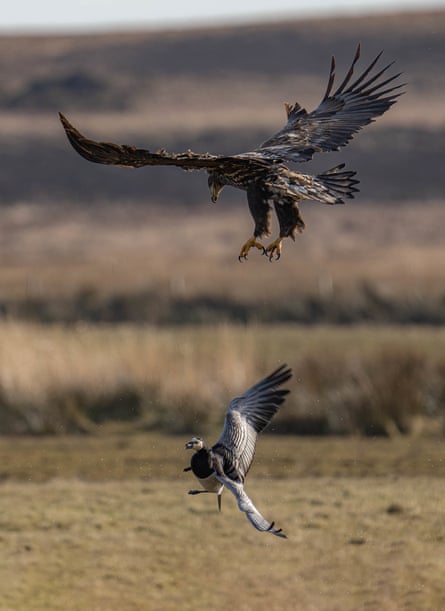Oh, isn’t it lovely to have a new David Attenborough series for a cosy Sunday evening. And one so close to home! For the next five weeks, Wild Isles offers an unparalleled look at the spectacular, miraculous and unique natural world of Britain and Ireland. It is a stunning portrait of breeding orcas, golden eagles, foxes and dormice; woodlands, meadows and rivers. Just beautiful. Something to be immensely proud of, something to nurture and to protect.
There is nothing like an Attenborough-led nature documentary, and this is likely to be his last on location. From its majestic score to its pioneering cinematography and its clever narratives, this is education by way of awe. “The British Isles are globally important for nature,” he says, before we follow an orca pod as they strategise ways of hunting their favourite food: a nice, juicy seal. They swim on their sides to hide their dorsal fins as they approach, which is amazing to see, then teach their young how to drown their prey. Fine family entertainment.
We see the oldest oak tree in Britain, which has been standing for 1,046 years and so predates the Norman Conquest. Wild Isles makes many claims for these isles’ exceptional nature, from the mighty oaks to the chalk streams that are one of the rarest habitats on Earth. There are only 200 or so of these mineral-rich waters in the world and 85% are in southern England. We see kingfishers, tawny owls and badger cubs. A segment dedicated to how the common lords-and-ladies pollinates is surprisingly intricate and absolutely stunning.
There is usually one headline set piece, a talking point destined for Gogglebox. Although there are plenty to choose from, I suspect it may be between the golden eagles fighting the barnacle goose – so thrilling it reminded me of Top Gun: Maverick (only without the military propaganda) – or the gulls versus the puffins, which had a strong air of Whac-A-Mole.

After the wonder and majesty, though, you know what’s coming. Attenborough usually doles out the bad news carefully, gradually, before ending each episode on more of a doomsday warning. The idea, I think, is that this makes it more palatable. Celebrate, then hit hard. He throws wonder after wonder at the screen, before gently informing us that, despite the preciousness of hay meadows, 97% of them have been lost in the past 60 years; that, despite the sheer beauty of design that allows a specific moth with a specific proboscis to extract pollen from a specific flower, 60% of the British Isles’ flying insects have vanished in the past 20 years.
There has been some controversy over a reportedly too-hot-to-broadcast – but OK to put out on iPlayer – “sixth episode” of Wild Isles (which the BBC claims is a “separate film inspired by the series” and was never going to air on BBC One), which will tackle the causes of these catastrophic declines. But this opener is sensitive, in a very BBC way, with a mildness that occasionally seems disproportionate to what is going on. It is as if nobody has been steering the ship towards the rocks through sewage-infested waters. Perhaps the captains will be unmasked at the end of the series. It isn’t until the final minutes of this episode that Attenborough delivers the hammer blow. “Though rich in places, Britain as a whole is one of the most nature-depleted places in the world,” he says.
This is shameful, but it doesn’t come from nowhere. In January, for the third year in a row, the UK government approved the “emergency” use of a banned insecticide on sugar beet; a single teaspoon of thiamethoxam is enough to kill 1.25 billion bees. Britain’s woodlands may be rare and complex, but a 2020 audit by the Wildlife Trusts reported that the environmental cost of the rail network HS2 had been vastly understated, particularly regarding ancient woodlands, which cannot simply be replaced.
Attenborough explains that “our seas are among the richest in Europe”, but who can hear that without thinking of the sewage flowing into those seas, again and again, dumped by UK water companies that in turn blame the government for its inaction? The only time I have seen the flash of a kingfisher was on the River Wye; Britons have been warned repeatedly that, due to runoff from intensive poultry farming, this river is dying.
after newsletter promotion
It is frustrating and infuriating that, if you have even a passing interest in nature, almost every awesome scene in this gorgeous documentary is tainted. There is a lack of urgency at every turn. If Wild Isles can make viewers aware of what they have, there is some hope, perhaps, that more people will become invested in saving it – and won’t settle for nothing being done. Who, if not Attenborough, will be able to nudge us towards demanding that action is taken immediately?
Wild Isles aired on BBC One and is now on BBC iPlayer

 1 year ago
96
1 year ago
96










 English (US)
English (US)